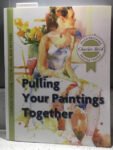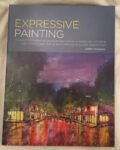You have to be patient waiting for the prices of these Charles Reid books to…

Painting By Design, Charles Reid – Book Review
This 144-page paperback is one of those books that’s difficult to categorise. The title and subtitle on the front page make it sound like it’s all about composition, which it definitely isn’t. It’s actually about other things but it’s difficult to pinpoint what exactly. I should point out, by the way, that I knew all this before adding the book to my wishlist.
The book starts off talking about contour drawing. In fact all four of the recently republished Charles Reid books do this, which makes me wonder how much duplication there is between books. Within this, there are hints about what’s to come, when Charles talks about merging shadowy sides and cast shadows together into single shapes, even when they’re different objects. And not drawing edges between objects if they’re hidden by shadow. But then he tells us contour drawing can look a bit stiff and talks about gestural, rhythmic sketching as an alternative. Obviously the best strategy is a combination.
And then we get on to painting. There seem to be two main focuses, sorry foci, here. One is portrait painting, with the chapters on figures and faces taking up about 30% of the book. And the other is painting like Charles, with a big emphasis on lost edges. Where two shapes have similar values, Charles likes to blend them together, even if they have different colours. And even if two shapes have different values, Charles likes to blend them together, but this means graduating values within shapes: the dark shape has to get lighter and the light shape darker as they approach the join. But not all edges are blurred like this. In particular, the edges in and around the focal point of the painting need to be sharp and accurate.
So it’s not really clear whether this is about portrait painting or about painting like Charles. Or how the drawing chapter fits in. But somehow it all fits together. And I think it’s because Charles has done the same trick as Frank Webb and applied his painting style to the writing of the book. The chapters don’t have hard edges but instead blend into each other. Not in a haphazard, disorganised way, but in a beautiful floaty Irish cream way. It actually made for a great read.
What about the content though? Well, there aren’t that many big ideas in the book. It’s all about getting values right and using soft edges where you don’t want the eye to dwell too long. And these ideas are illustrated by using lots of examples. On the other hand, there are a lot of little nuggety tips within this book. Little tricks of the trade that I’ve never seen mentioned in other books, especially in the chapter on faces. So many other books talk about how to draw eyes, ears, noses, etc but Charles doesn’t do that. He talks about how to draw faces and includes some amazing tips.
This is a really good book. Full of interesting tips, introducing a style of painting that I want to try and acting as a gentle introduction to painting (rather than drawing or sketching) people. It’s expensive but worth every penny. I don’t have any of Charles’ other books so can’t comment on its attributes relative to them but looking at this in isolation, it’s a five paletter.
You can find this book and more reviews of it at Amazon UK here. As an Amazon Associate, I earn commission from qualifying purchases but this costs absolutely nothing extra to you.








Leave a Reply